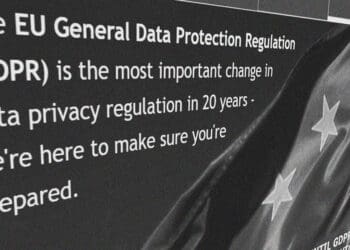How Businesses Can Minimize Their Risk
It is estimated that well over half of U.S. businesses are out of compliance with the GDPR regulations set to take effect on May 25. Businesses are simply unprepared because they struggle with understanding the regulations and whether or not they are affected. Greg Sparrow touches on issues of GDPR, why businesses fail to meet compliance and what they can do to mitigate their risk.
The General Data Protection Regulation (“GDPR”) is one of the most important topics of conversation for media, along with how it will affect U.S. companies. Since its inception, the GDPR has raised a number of questions as to whether businesses are properly prepared to comply. The GDPR was adopted on April 27, 2016 and allotted a two-year post-adoption grace period for businesses to strategize and implement their compliant approach. With only one month left, it has been reported that an estimated 61 percent of U.S. businesses are not ready for the regulation, and only 67 percent of European-based businesses have begun moving into the implementation phase of their GDPR compliance program.[1] The potential fines have many businesses and professionals concerned about compliance as the May 25, 2018 date of enforcement approaches, yet businesses continue to struggle with fully understanding the regulation and thus fail to launch a comprehensive plan.
Turning our focus to the retail industry, several chains have displayed international influence with the presence of not only brick-and-mortar stores in several nations, but through international marketing efforts. A well-known example includes Whole Foods, an American supermarket chain that previously held over 477 stores in North America and the United Kingdom. After Amazon’s acquisition of the natural foods company in June 2017, the e-commerce giant became America’s fifth-largest grocery retailer. Outside of the benefit of concrete locations near its customers, the marketing data obtained through the acquisition provided Amazon valuable behavioral statistics on grocery-buying habits, patterns and product preferences. It is estimated that over 80 million individuals are Amazon Prime members and, with this new data, Amazon can build accurate predictive analytic models that can suggest to Prime members what they will want, how much they will want and when they will want it.
The GDPR places Amazon’s acquired Whole Foods business unit under scope for not only its presence in the United Kingdom, but also due to its monitoring of European Union (“EU”) data subjects and its attempt to offer them goods and/or services. Amazon’s practices most likely include the use of automated individual decision-making against EU citizens, requiring explicit consent under the GDPR. Processing is broadly defined in the regulation to include most actions that can be performed with data and can specifically refer to collection and storage, which Amazon in this case would be doing. The massive retailer must therefore have processes in place to honor nine distinct rights awarded to EU data subjects, and it must be able to operate under the guiding privacy principles defined within the GDPR. The regulation further dictates appropriate security efforts around the protection of personal data, establishes breach reporting requirements and increases the risk associated with vendors processing this data. These expansive requirements make the process of marketing and vendor outsourcing much more complex for anyone with a direct consumer relationship with EU data subjects.
Many smaller agencies may not be considering the new regulations as seriously as they should be, but past enforcement actions point to enforcement risk, even with smaller agencies. The GDPR states that noncompliant companies posing a risk to EU citizens and their privacy can be fined up to €20 million or 4 percent of their global turnover for the previous fiscal year, whichever is greatest. For companies like Amazon, with a net revenue around $178 billion in 2017, they could potentially face a fine of $7.1 billion. It is important to note that this fine would be per violation. It can certainly be assumed that larger repercussions would be imposed in this hypothetical case, since case law suggests similar types of violations do not stand alone, instead typically occurring with others.
There are several steps that companies must immediately undertake to mitigate their exposure to risk. A solid start begins with understanding GDPR regulation applicability to various parts of the business and understanding each unit’s risk profile in order to establish priorities for the initiative. Once risk and priorities have been identified, it is critical for organizations to identify and establish their lawful basis for processing of this data.
Every industry has its own unique risk and operational challenges, and every business within has its own maturity relative to industry peers. Using the trusted counsel of a compliance firm helps to quickly identify both industry and organizational risk that are often otherwise overlooked for non-biased third parties. A risk management and compliance consulting firm can help organizations quickly identify risk, formulate a plan to mitigate this risk and set up ongoing monitoring programs to maintain valuable records of compliance.
Some have suggested the GDPR will set the global precedent for data privacy and security regulations. Brazil and China have both showed interest in forming similar requirements to protect the privacy of their citizens’ personal information from businesses storing and transferring data across borders.
To adequately prepare for the GDPR and similar regulations likely to be introduced in the future, businesses must begin educating themselves on these regulations and forming a strategy for how to conquer the requirements. Applicable processes and procedures can obviously help minimize exposure to fines, but they can also provide an opportunity within the market to reassure customers and in return, earn their trust.
[1] Source – Iapp.org “Survey: 61 percent of companies have not started GDPR implementation”



 Greg Sparrow is Senior Vice President and General Manager at CompliancePoint. Greg has enjoyed over 17 years of experience in privacy, information security and risk management. Greg has had the pleasure of working on both US based and international projects. He was responsible for the development and implementation of the security program’s responsible for protecting billions of dollars in annual transaction volume. Greg’s most recent work includes security and certification work for Samsung Pay, enterprise risk management for multiple NFL and MLB sports teams and helping to secure critical infrastructure at some of the nation’s largest transit hubs.
Greg holds multiple IT and security certifications covering the Healthcare Industry, Payment Card Industry and federal banking standards.
Greg Sparrow is Senior Vice President and General Manager at CompliancePoint. Greg has enjoyed over 17 years of experience in privacy, information security and risk management. Greg has had the pleasure of working on both US based and international projects. He was responsible for the development and implementation of the security program’s responsible for protecting billions of dollars in annual transaction volume. Greg’s most recent work includes security and certification work for Samsung Pay, enterprise risk management for multiple NFL and MLB sports teams and helping to secure critical infrastructure at some of the nation’s largest transit hubs.
Greg holds multiple IT and security certifications covering the Healthcare Industry, Payment Card Industry and federal banking standards.










